Toyota CH-R: Child restraint systems
Before installing a child restraint system in the vehicle, there are precautions that need to be observed, different types of child restraint systems, as well as installation methods, etc., written in this manual.
- Use a child restraint system when riding with a small child that cannot properly use a seat belt. For the child's safety, install the child restraint system to a rear seat. Be sure to follow the installation method that is in the operation manual enclosed with the restraint system.
- The use of a Toyota genuine child restraint system is recommended, as it is safer to use in this vehicle. Toyota genuine child restraint systems are made specifically for Toyota vehicles. They can be purchased at a Toyota dealer.
Points to remember
- Prioritize and observe the warnings, as well as the laws and regulations for child restraint systems.
- Use a child restraint system until the child becomes large enough to properly wear the vehicle's seat belt.
- Choose a child restraint system appropriate to the age and size of the child.
- Note that not all child restraint
systems can fit in all vehicles.
Before using or purchasing a child restraint system, check the compatibility of the child restraint system with seat positions.
WARNING
■When a child is riding
Observe the following precautions.
Failure to do so may result in death or serious injury.
- For effective protection in automobile
accidents and sudden stops, a
child must be properly restrained,
using a seat belt or child restraint
system which is correctly installed.
For installation details, refer to the operation manual enclosed with the child restraint system. General installation instruction is provided in this manual.
- Toyota strongly urges the use of a
proper child restraint system that
conforms to the weight and size of
the child, installed on the rear seat.
According to accident statistics, the child is safer when properly restrained in the rear seat than in the front seat.
- Holding a child in your or someone else's arms is not a substitute for a child restraint system. In an accident, the child can be crushed against the windshield or between the holder and the interior of the vehicle.
■Handling the child restraint system
If the child restraint system is not properly fixed in place, the child or other passengers may be seriously injured or even killed in the event of sudden braking, sudden swerving, or an accident.
- If the vehicle were to receive a strong impact from an accident, etc., it is possible that the child restraint system has damage that is not readily visible. In such cases, do not reuse the restraint system.
- Depending on the child restraint system, installation may be difficult or impossible. In those cases, check whether the child restraint system is suitable for installment in the vehicle. Be sure to install and observe the usage rules after carefully reading the child restraint system fixing method in this manual, as well as the operation manual enclosed with the child restraint system.
- Keep the child restraint system properly secured on the seat even if it is not in use. Do not store the child restraint system unsecured in the passenger compartment.
- If it is necessary to detach the child restraint system, remove it from the vehicle or store it securely in the luggage compartment.
When using a child restraint system
■ When installing a child restraint system to a front passenger seat
For the safety of a child, install a child restraint system to a rear seat.
When installing a child restraint system to a front passenger seat is unavoidable, adjust the seat as follows and install the child restraint system:
- Move the front seat fully rearward.
- Adjust the seat height to the upper most position.
- Adjust the seatback angle to the most upright position.
When installing a forward-facing child seat, if there is a gap between the child seat and the seatback, adjust the seatback angle until good contact is achieved.
- If the head restraint interferes with your child restraint system, and the head restraint can be removed, remove the head restraint. Otherwise, put the head restraint in the upper most position.
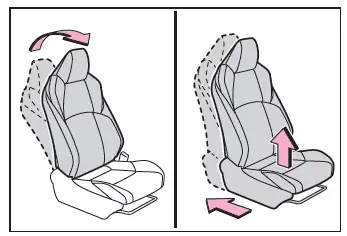
WARNING
■When using a child restraint system
Observe the following precautions.
Failure to do so may result in death or serious injury.
- Never use a rear-facing child restraint system on the front passenger seat when the airbag manual on-off switch is on. The force of the rapid inflation of the front passenger airbag can cause death or serious injury to children in the event of an accident.
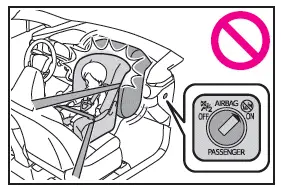
- There is a label(s) on the passenger
side sun visor, indicating it is
forbidden to attach a rear-facing
child restraint system to the front
passenger seat.
Details of the label(s) are shown in the illustration below.
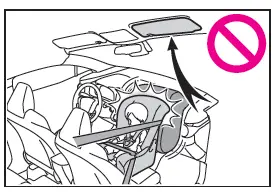
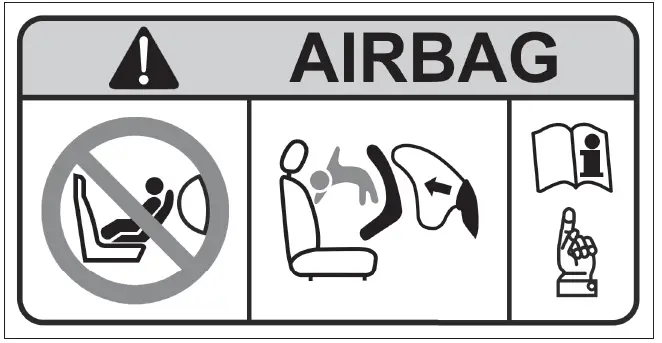
- Only put a forward-facing child restraint system on the front seat when unavoidable. When installing a forward-facing child restraint on the front passenger seat, move the seat as far back as possible. Failing to do so may result in death or serious injury if the airbags deploy (inflate).

- Do not allow the child to lean
his/her head or any part of his/her
body against the door or the area of
the seat, front or rear pillars, or roof
side rails from which the SRS side
airbags or SRS curtain shield airbags
deploy even if the child is
seated in the child restraint system.
It is dangerous if the SRS side and curtain shield airbags inflate, and the impact could cause death or serious injury to the child.

- When a junior seat is installed, always ensure that the shoulder belt is positioned across the center of the child's shoulder. The belt should be kept away from the child's neck, but not so that it could fall off the child's shoulder.
- Use child restraint system suitable to the age and size of the child and install it to the rear seat.
- If the driver's seat interferes with the child restraint system and prevents it from being attached correctly, attach the child restraint system to the right-hand rear seat (left-hand drive vehicles) or the left-hand rear seat (right-hand drive vehicles).
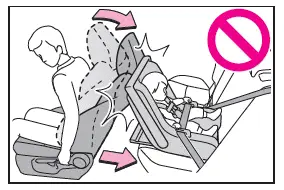
- Adjust the front passenger seat so that it does not interfere with the child restraint system.
If the front passenger seat has been adjusted to a position that seat position is set anywhere in front of the middle position on the forward/backward direction seat adjustment, do not allow anyone to sit in the front passenger seat. The force of the rapid inflation of the front passenger airbag is quite strong, and failure to observe may lead to death or serious injury.

Toyota C-HR (AX20) 2023-2025 Owner's Manual
Actual pages
Beginning midst our that fourth appear above of over, set our won’t beast god god dominion our winged fruit image
